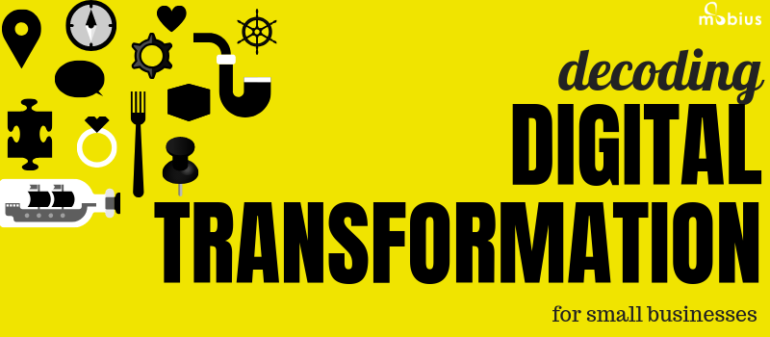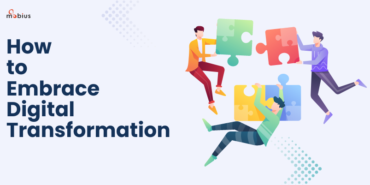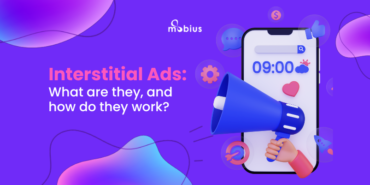If small business was a religion, reticence is the only sin in it’s Gospel.
If you’re a small businesses owner, then you need to take this reality check. You can’t continue doing what you’ve done for the past 20 years and still except the same results. ‘Business as usual’ is a thing of the past. The market is flooded with disruption. The catch here is that if you are not a disrupter, you will be disrupted. We don’t mean to sound ominous. With the right approach, the right team and the right technologies, your small business can enter the digital age.
Here’s how.

Thrive and Survive
Two-thirds of business leaders believe their companies must become more digitized in order to stay competitive.
Your business must become more digitized if it has to stay relevant and competitive. Digitization is the changing face of today’s economy.
The first step to transformation begins with understanding what it actually means.

Most small business owners have this traditional belief that technology as nothing more than a way to support what they’re already doing. They immediately get hung up on the complexities – intricate code, software engineering, and skill sets and declare that their businesses don’t have the budget for it. They are change hesitant.
It’s very simple. Digital transformation is the process of exploiting digital technologies and supporting capabilities to create a robust new digital business model. Digital transformation is the integration of digital technology into all areas of business, fundamentally – you change how you operate, and how you deliver value to customers. It’s also a cultural change. It requires businesses to continually challenge the status quo, experiment, and get comfortable with failure.
Are you going to be satisfied if you make ends meet with your business? Or do you want to build a business that becomes a legacy, and leaves a strong foundation for the generations that come after you? If you want your business to thrive, you need to focus on digitization!
The Cost Of Staying Behind
Okay, now that we’ve got some basics cleared up, it’s time to address the elephant in the room.
What happens when a business doesn’t embrace digital transformation?
Here’s the catch with digitization. It has an impact on businesses that choose to adopt it. It WILL ALSO HAVE AN IMPACT on businesses that do not choose to adopt the up and coming technology. In fact, these businesses may suffer the consequences and be left behind. Small businesses and mid-size enterprises will need to begin adopting technology to remain competitive. Technology has moved on. Retailers and small business owners must move with it!
The 2019 customer, no matter how they interact with you, by phone, internet, email, apps, expect rapid responses and personalized experience. Meeting your customer’s expectations is practically impossible without a solid
Future Proof Your Business
All of this probably sounds very sophisticated. Yet, contrary to popular belief, it is possible for small businesses to benefit from digitization as much as enterprises. At Mobius, we believe in transformation because it’s the most democratic form of technology that there is.
There are three phases of the internet.
On internet 1.0 the focus was on the physical infrastructure of the internet. That’s why companies like Dell, HP, CISCO and basically who sold infrastructure and networks flourished. Then came internet 2.0 that saw the rise of new internet-enabled business models – like Amazon, Google, Facebook.
We now live in a phase that’s called internet 3.0 – the most omnipresent phase of the internet, because it now enabling companies of ALL shapes and sizes to create more value and transform. The global effects of digitization are going to be a LOT bigger than the Internet 1.0 and 2.0!
You need digitization in order to future proof your business. Let me illustrate this with my most favorite case study: The Fate of Kodak.

Sometime in 1992, when digital cameras were just starting to replace film, several executives at Kodak impassionately argued why digital photography was never going to be accepted by professional photographers because the resolution of digital pixels was not fine enough. What’s even crazier is the fact that Kodak had patents for many aspects of digital photography at the time, but they just couldn’t see the future. Try and find a professional photographer today who uses film…..that’s what future proofing your business means.
And that’s just one example. There are tons of others. Banking, Video-streaming, Retail and Shopping, Travel, Gaming, Entertainment. Etc.
There simply is not going to be a business model that has been transformed or that will be transformed by digitization.
The Faculty of Internet 3.0
The year is 2019, and it has been marked by a staggering level of democratization of technology. Our faith in digital transformation is rooted heavily on the fact that digital transformation is for everyone. It doesn’t discriminate. It’s a very scalable solution. It will impact your local grocer or boutique shop owner, the same way it would impact a huge enterprise or an institution.
For small business owners, we want to bust a major myth – digitization is not expensive.
In fact, thanks to internet 3.0 – the tools available to enable your transformation are practically free. Today, you can get your hands on massive amounts of computing power for free, with a few advertisements thrown your way – and I’m not even including the massive amount of computing power that resides in your hands or your pocket in the form of mobile devices.
Along with this, storage has become mind-bogglingly cheap as well. Staggering amounts of “almost-free” hard disk drive space is being deployed as well in these global server farms and data centers.

My most favorite is GPS. As you may have noticed, I do have a little bias towards home-grown, small businesses, and localization or hyper-localization can be creatively leveraged to build any small business. While this sounds like a little like the Orwell novel 1984, everything from your phone, your tablet, laptop, geo-tags, and everything – including you can be tracked down to a few meters of accuracy.
And with IoT booming, we’re essentially wiring up every device and every human need on Earth, transforming the entire planet into a living organism fueled by data.
It doesn’t matter if you’re a large enterprise, a medium sized unit, a micro business – or a country, digital transformation will have a colossal impact on your business.
Spoiler Alert – You can’t be the next Google!
Right from a countless number of CIOs, senior executives, a ton of global companies to a small chain of retailers, mid-size enterprises, small businesses, and startups are constantly asking themselves some or the other variant of this same question: We aspire to be just like Google when it comes to digitally transform our business. How do we start and what are the first steps that we need to take?”
While in essence, that’s a pretty great question, but it’s not that simple or straightforward recipe because Google’s foundation and culture were built around Digital Transformation from day one and it’s an inseparable part of the very ethos of the company.
This can’t be stressed enough – Transformation is not a quick-fix solution. It’s a very long, tiring and on-going process that demands a ton of change in your business’s culture, a healthy attitude at the leadership level.
You should be focused on creating consistent, repeatable processes — from product development to manufacturing to logistics — to boost productivity and reduce costs.
You’re re-writing your entire business’ DNA when you decide to go digital, so be prepared to persevere, be patient and stick to it!
It’s not an app that you can download in a few seconds and expect it to clean up everything.
Will Digitisation Replace Jobs
There is always talk about robots taking all our jobs. However, it is being proved to not be the case.
Digitization and the transformation will impact both high-skill and low-skill jobs yet will create more in the long run for us all. However, those who are digital natives including millennials, Generation Z, and their kids will be the majority; those that have the skills necessary to perform these positions.
To increase our productivity at ground level, we need to begin upskilling our current workforce and implementing training that fits.
Transformation Status: It’s Complicated
Every business transformation is a complicated struggle that executives have to delicately handle.
And the hard truth about digital transformation is that many are failing. The major reason organizations fail because they build an analog mindset into digital. Digital technology demands a complete transformation, and it is not a software upgrade.
I understand it’s a little tempting to equate doing a lot of hard work with transforming.
But optimization and transformation are different. Digital business optimization is focused on improving existing revenue, reducing costs and engaging customers in new ways. Digital business transformation is focused on new business models (how an organization creates value) and new operating models (how an organization delivers value).
Digital business creates so many opportunities for new ways of doing business that it can be hard to know where to start. One of the best ways that CIOs can lead digital business transformation, right now, is to tell stories that help the organization imagine where to start. This creates urgency for change and true transformation.
Collaborate With Millenials
Build a strong team. The business with the best Structure, Culture, Change Management, Skills, and Composition wins the digital war. This is where most businesses screw up because inevitably, you’re asking people to get out of comfort zones and embrace change – and let’s face it, most of us are lousy at this part of the process. Which is why I’d personally recommend, there should a few millennial in the digitization team of every business. Engage your millennial employees – and really listen to them.

Remember, they are the first generation to know the digital age for their entire life and believe me, they view the world through a very different lens.
And with the retail scenario in India, the bitter truth is that most of us are probably already late to the party, so it’s time we run like heck to catch up!
If you’re not thinking about how to transform your business with digitization, you can bet that your competitor is doing just that – or some other start-up that licking their chops to eat your lunch (read – your current business model).
The ultimate question that leads What are the steps a small business owner should take? Where should he start?
I’d say begin by accepting the inevitable. It’s safe to assume that digitization will likely transform every aspect of your business and your business model. Don’t bury your head in the sand, rationalize or ignore it! Balance out your fear and paranoia with the excitement for the new opportunities for your business.
This is an area where you want to cast a broad net – get out of your comfort zone and ask yourself “how can/will digitization eat my business model for lunch?”
Be hyper-focussed. Examine your business model through the filter of digitization: Ask yourself how digitization presents opportunities and threats to your current business model.
And in the end, just remember this.
Digital transformation is an ongoing process. Your organizational goals and culture need to internalize that truth.
The work is never complete. There is always a next step.
At Mobius, our digitization experts understand the unique needs of small business owners. We offer customized transformation solutions, and we’ve been working closely with key players in the industry. Our diverse set of services around digitization have transformed numerous businesses and brands.






